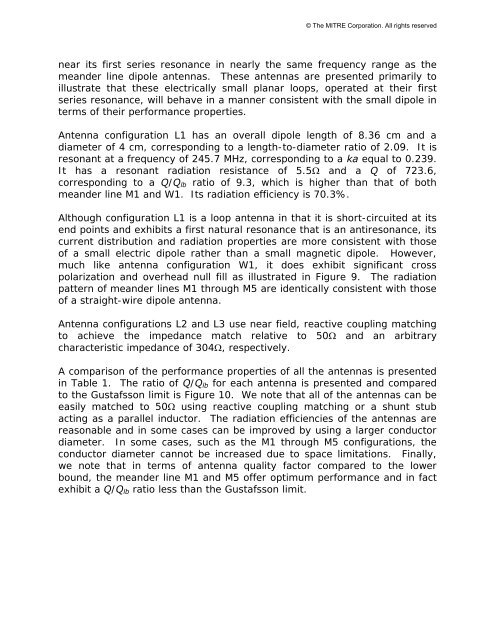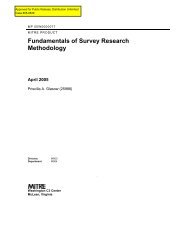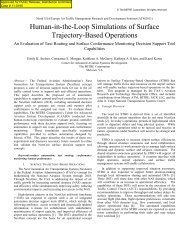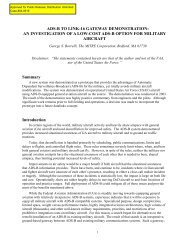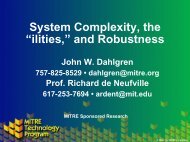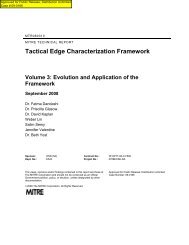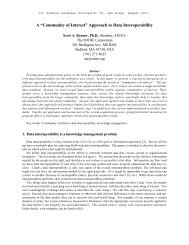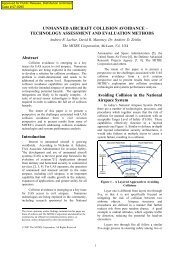Optimization of the Bandwidth of Electrically Small Planar Antennas
Optimization of the Bandwidth of Electrically Small Planar Antennas
Optimization of the Bandwidth of Electrically Small Planar Antennas
Create successful ePaper yourself
Turn your PDF publications into a flip-book with our unique Google optimized e-Paper software.
© The MITRE Corporation. All rights reserved<br />
near its first series resonance in nearly <strong>the</strong> same frequency range as <strong>the</strong><br />
meander line dipole antennas. These antennas are presented primarily to<br />
illustrate that <strong>the</strong>se electrically small planar loops, operated at <strong>the</strong>ir first<br />
series resonance, will behave in a manner consistent with <strong>the</strong> small dipole in<br />
terms <strong>of</strong> <strong>the</strong>ir performance properties.<br />
Antenna configuration L1 has an overall dipole length <strong>of</strong> 8.36 cm and a<br />
diameter <strong>of</strong> 4 cm, corresponding to a length-to-diameter ratio <strong>of</strong> 2.09. It is<br />
resonant at a frequency <strong>of</strong> 245.7 MHz, corresponding to a ka equal to 0.239.<br />
It has a resonant radiation resistance <strong>of</strong> 5.5 and a Q <strong>of</strong> 723.6,<br />
corresponding to a Q/Qlb ratio <strong>of</strong> 9.3, which is higher than that <strong>of</strong> both<br />
meander line M1 and W1. Its radiation efficiency is 70.3%.<br />
Although configuration L1 is a loop antenna in that it is short-circuited at its<br />
end points and exhibits a first natural resonance that is an antiresonance, its<br />
current distribution and radiation properties are more consistent with those<br />
<strong>of</strong> a small electric dipole ra<strong>the</strong>r than a small magnetic dipole. However,<br />
much like antenna configuration W1, it does exhibit significant cross<br />
polarization and overhead null fill as illustrated in Figure 9. The radiation<br />
pattern <strong>of</strong> meander lines M1 through M5 are identically consistent with those<br />
<strong>of</strong> a straight-wire dipole antenna.<br />
Antenna configurations L2 and L3 use near field, reactive coupling matching<br />
to achieve <strong>the</strong> impedance match relative to 50 and an arbitrary<br />
characteristic impedance <strong>of</strong> 304, respectively.<br />
A comparison <strong>of</strong> <strong>the</strong> performance properties <strong>of</strong> all <strong>the</strong> antennas is presented<br />
in Table 1. The ratio <strong>of</strong> Q/Qlb for each antenna is presented and compared<br />
to <strong>the</strong> Gustafsson limit is Figure 10. We note that all <strong>of</strong> <strong>the</strong> antennas can be<br />
easily matched to 50 using reactive coupling matching or a shunt stub<br />
acting as a parallel inductor. The radiation efficiencies <strong>of</strong> <strong>the</strong> antennas are<br />
reasonable and in some cases can be improved by using a larger conductor<br />
diameter. In some cases, such as <strong>the</strong> M1 through M5 configurations, <strong>the</strong><br />
conductor diameter cannot be increased due to space limitations. Finally,<br />
we note that in terms <strong>of</strong> antenna quality factor compared to <strong>the</strong> lower<br />
bound, <strong>the</strong> meander line M1 and M5 <strong>of</strong>fer optimum performance and in fact<br />
exhibit a Q/Qlb ratio less than <strong>the</strong> Gustafsson limit.


